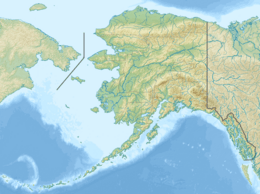Mount Steller (Aleutian Range) facts for kids
Quick facts for kids Mount Steller |
|
|---|---|

Mount Steller (to left) in August 2003
(Mount Denison is to the right) |
|
| Highest point | |
| Elevation | 7,454 ft (2,272 m) |
| Prominence | 1,600 ft (490 m) |
| Geography | |
| Location | Katmai National Park and Preserve, Alaska, U.S. |
| Parent range | Aleutian Range |
| Geology | |
| Mountain type | Stratovolcano |
| Volcanic arc/belt | Aleutian Arc |
Mount Steller is a large stratovolcano located in Katmai National Park in Alaska, United States. It is part of the Aleutian Range, a long chain of mountains and volcanoes. This impressive peak stands on the Alaska Peninsula, a strip of land that stretches out into the Pacific Ocean.
Contents
What is Mount Steller?
Mount Steller is a type of volcano known as a stratovolcano. It stands tall at 7,454 feet (about 2,272 meters) above sea level. This makes it a significant landmark in the wild and beautiful Alaskan landscape. The mountain is part of a larger group of volcanoes called the Aleutian Arc.
A Closer Look at Stratovolcanoes
Stratovolcanoes are also called composite volcanoes. They are cone-shaped volcanoes built up by many layers of hardened lava, tephra, pumice, and volcanic ash. These volcanoes are known for their explosive eruptions. Mount Steller has likely had such eruptions in the past.
Where is Mount Steller Located?
Mount Steller is found within Katmai National Park and Preserve. This park is famous for its stunning scenery and abundant wildlife. The volcano is in a remote area of Alaska. It is part of the Aleutian Range, which is a long mountain chain. This range includes many other volcanoes.
The Alaska Peninsula
The Alaska Peninsula is a narrow piece of land. It extends for about 500 miles (800 km) southwest from the mainland of Alaska. This peninsula separates the Pacific Ocean from Bristol Bay. It is home to many volcanoes, including Mount Steller.
The History of Mount Steller
Mount Steller is believed to have erupted during the Holocene epoch. The Holocene epoch is the current geological period. It began about 11,700 years ago. While there isn't exact proof, scientists think the volcano was active during this time. This means it could have erupted when humans were already around.
Who Was Georg Wilhelm Steller?
The mountain was probably named after Georg Wilhelm Steller. He was a famous German naturalist and explorer. A naturalist studies plants and animals. Steller explored parts of Alaska in the 1740s. He was the first European to describe many Alaskan animals and plants. It is thought that this important scientist was honored by having the volcano named after him.


